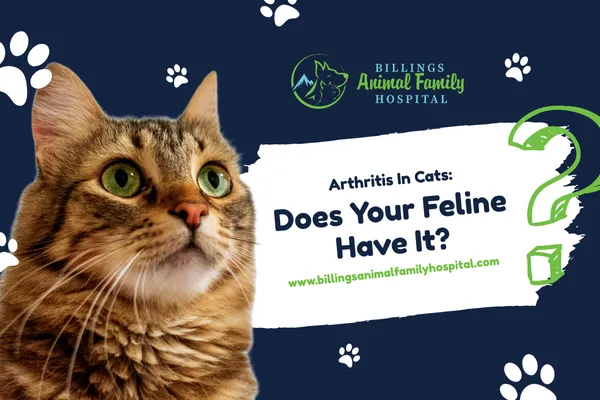
Arthritis In Cats: Does Your Feline Have It?
Arthritis In Cats: Does Your Feline Have It?
As our beloved cats get older, it's not uncommon for them to slow down a bit, but sometimes, that slowdown is due to something more than just age. Arthritis affects more than 60% of cats over 6 and up to 90% of cats over 12, yet the signs often go unnoticed. Cats are masters at hiding discomfort, so spotting those early signs of joint pain can be tricky.
We’re here to help you understand the subtle shifts that might mean your cat is hurting. With the right care and attention, you can ease their pain and help them stay active and comfortable. Let’s take a closer look at feline arthritis and what you can do to support your cat’s health and happiness.
What You'll Find In This Post . . .
Arthritis In Cats: Does Your Feline Have It?
Understanding arthritis in cats
Recognizing signs of arthritis in cats
How to manage and treat feline arthritis long term
Worried about feline arthritis? Set up a veterinary appointment
Understanding arthritis in cats
Arthritis is an inflammatory disease affecting the joints, most commonly the elbows, hips, knees, and spine. This degenerative joint disease is surprisingly common in cats. Once the cartilage that cushions the joints begins to break down, the bones start rubbing against each other, leading to pain, stiffness, inflammation, and decreased mobility.
However, cats are masters at hiding pain, and the subtle signs of arthritis they exhibit often go unnoticed. While most people assume only an older cat is at risk, arthritis in cats is not solely an age-related condition. The disease can also be triggered by:
Broken bones
Torn ligament trauma
Genetic disposition
Developmental disorders
Increased joint wear and tear attributable to obesity or age
Recognizing signs of arthritis in cats
Because cats are so adept at masking pain, spotting their signs of pain can be a challenge. Many cats conceal obvious pain indications until the condition has progressed to the point that their pain becomes unbearable, and their behavior changes become obvious. Early detection is essential to slowing the disease’s progression, maintaining your cat’s mobility, and easing their discomfort. Your cat may have arthritis if they exhibit the following behavior changes:
Decreased mobility — Your cat may become reluctant to jump up or down, step over their litter box rim, or use stairs. They may appear stiff when walking or jumping. Cats with arthritis will naturally restrict their sore joint’s use, becoming less active and sleeping more. You might also notice hesitancy when approaching food and water bowls if bending causes discomfort.
Grooming changes — Cats are meticulous groomers, but arthritis can make the simple act of cleaning themselves painful and challenging. Look for overgrooming or undergrooming signs, both of which indicate discomfort and possible pain and inflammation in their back legs or spine.
Personality changes — Arthritic cats may become irritable, withdrawn, or aggressive, particularly when touched in certain areas.
Left untreated, arthritis causes chronic stiffness, range-of-motion loss, lameness, reduced mobility, and a poor quality of life. If your whiskered pal exhibits any of these signs of arthritis, consult our Billings Animal Family Hospital team, so our veterinarian can properly diagnose your cat’s condition and initiate a tailored treatment option.
Diagnosing feline arthritis
Many feline conditions cause similar behavioral and personality changes. To rule out other potential causes and to diagnose osteoarthritis accurately, our veterinary team does a thorough physical examination, reviews your cat’s medical history, and performs diagnostic testing. Sometimes, arthritis can be secondary to another condition, such as diabetes, so we may recommend additional tests to make a comprehensive diagnosis.
However, for the first-line tests, our team often recommends the following diagnostic screenings:
Complete blood count (CBC)
Blood chemistry panel
Urinalysis
X-rays to check for joint damage or inflammation
How to manage and treat feline arthritis long term
Although arthritis has no cure, our veterinarian can manage your cat’s pain, maintain their mobility, and improve their quality of life. Frequent veterinary visits are essential for monitoring your cat’s condition, so we can adjust their treatment as needed. Treating arthritis in cats may include one or more of the following treatment options:
Solensia (frunevetmab) — This new monoclonal antibody injection is a once-monthly treatment option that targets a substance in the arthritis pain pathway. It’s designed for use in cats and can provide significant relief.
Joint supplements — Glucosamine, chondroitin, and omega-3 fatty acids can help reduce inflammation and support cartilage health in cats with arthritis.
Laser therapy — Cold lasers use specific light wavelengths to improve local circulation and tissue healing. This is a great non-invasive option for reducing pain and inflammation.
Acupuncture — Fine needles inserted into specific points can help relieve inflammation and discomfort. Many cats tolerate this therapy well.Surgery — In severe cases, surgery may include joint fusion or even amputation. However, this is typically considered a last resort.
NSAIDs (Nonsteroidal Anti-Inflammatory Drugs) — These anti-inflammatory drugs can be used under strict veterinary supervision to manage pain in arthritic cats.
Worried about feline arthritis? Set up a veterinary appointment
By learning to recognize subtle changes in your cat's behavior, you can identify discomfort signs and prevent your whiskered pal from suffering in silence. If your cat is exhibiting arthritis signs, schedule an appointment with our Billings Animal Family Hospital team. We’re experienced in treating arthritis in cats and can help ensure your cat enjoys a good quality of life.


